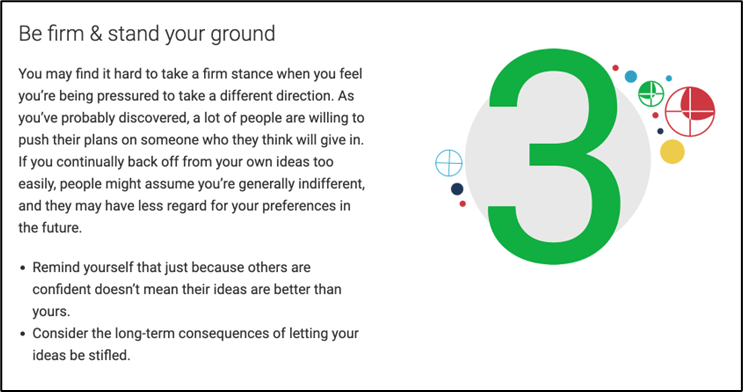Learn how to use the Workplace section of Everything DiSC’s Catalyst platform
This three-part series on Catalyst will show you every feature of this powerful learning platform to help you find your way and start improving your professional life. Here are the highlights of this Catalyst series:
Part I – Introduction to the platform and a deep dive into the ‘Your colleagues’ section
Part II – A detailed review of the Workplace section
Part III – A look into Catalyst’s Management section that focuses on developing managerial capabilities
Mateo Learns about Himself and Others
In our previous article, we saw how Mateo tackled the issue of working successfully with a colleague he thought was tough to work with. Using Catalyst, he developed a collaboration strategy to work with Elena – the ‘tough’ colleague. And the results amazed him! She turned out to be a breeze to work with and a powerhouse for the team.
Motivated by the results, Mateo logged in to his Everything DiSC Catalyst again to see what else can it do for him.
Catalyst’s Workplace
When he clicked on the Workplace menu, Mateo discovered that the Workplace section is divided into three parts. Here is what he saw:

A. What Drives You
This section gave Mateo insights into his own working style and preferences. It helped him understand what drives him and made him more aware of his own strengths and weaknesses. This detail paved the way for him to overcome his weaknesses and double down on his strong areas.
Following is a brief account of the three parts of this section.
i) Workplace Priorities
This section starts with a DiSC map where Mateo could see his own style plotted on it. On the outside of the DiSC map, he saw his workplace priorities, highlighting where he is likely to focus his energy.
Since Mateo is an SC style, he saw that the map pointed toward three priorities: Accuracy, Stability, and Support. But he noticed that he also had a fourth priority: Action. While Action isn’t a typical priority for someone with the SC style, Mateo was amazed at the accuracy! A closer look at the details given for each priority left him awestruck. A few statements about his priorities grabbed his attention, including, “You focus on maintaining stability…,” “…you’re willing to put your own needs aside to give the support that’s needed,” and “…you appear to place a high value on swift, immediate progress…”
ii) Your Motivators & Stressors
This part gave Mateo insights into what moves him forward and what bogs him down.
Again, he was astonished to see Catalyst’s accuracy in describing him. He wondered, “How could a short questionnaire describe me with such precision?”
At the end of this part, Mateo took notes of what motivated him so that he could maximize the presence of those elements wherever possible. He also made note of his major stressors with the intention to avoid them as much as he can. For the “Working without clear guidelines” stressor, he wrote down that before starting a new project he would try to get as much information about the task or project as he could.
Quite happy to have learned all this about himself, he moved to the last part of the ‘What Drives You’ section, which would focus on helping him create strategies to be more effective at work.
iii) Strategies
In this part, Mateo saw that the Catalyst engine had developed the top three things he could do to thrive at work. Based on his priorities, and on his motivators and stressors, the strategies were personal and actionable. They included specific tasks Mateo could do, each strategy designed to improve his workplace relationships. For example, Mateo wanted to learn how to stand his ground, and his third strategy included these tips:

After reading these strategies, Mateo felt like he had hired a workplace effectiveness coach and these strategies are what she has designed just for him! After this self-realization session, Mateo navigated to the second module which was about optimizing his interactions with his colleagues.
B. You and other styles
Mateo soon realized that this part of Catalyst is designed to increase his awareness of what drives his colleagues so he can have a better understanding of why they do the things they do. To cover all his colleagues and their DiSC styles, Catalyst gave a detailed view of each style.
Catalyst then gave details on what motivates people with the D people and where Mateo stood on each of those values. The next element was quite interesting and informative for Mateo. It consisted of a few short video interviews of D-style professionals where they answered specific questions about their style.
Mateo zipped through all the videos and after watching them he understood how a colleague with the D-style thinks and how he could work with them to achieve results.
At the end of this section was a list of Mateo’s colleagues who had taken an Everything DiSC assessment on Catalyst who had the D style. Using this information, Mateo realized what motivated each colleague so he could create mental maps of who stands where on the DiSC map.
C. Build Better Relationships
The third and last part of the Workplace module focused on building effective and lasting relationships by learning what Mateo needs to improve and how to get through less-than-ideal situations with someone. Information about connecting with each of the four styles was included, offering specific tips on how to connect in various situations.
- When you need to be more effective – this point addressed the areas where Mateo needed to overcome his shortfalls and improve his workplace relationships with his colleagues. For example, when working with someone with the i style, one of the tips is to recognize the value of personal connections.
- When problems need to be solved – this highlighted the situations where Mateo should emphasize the other person’s responsibility for keeping the relationship in the right direction. A helpful tip for Mateo when trying to solve problems with a C style colleague is to avoid getting bogged down in details.
- When things get tense – here Mateo learned strategies for whenever a relationship with any DiSC style got stressful.
Conclusion
All relationships take effort, but using Everything DiSC Catalyst’s Workplace section, you can:
- Get deep insights into your own working behaviors and attitudes
- See where others are coming from and understand how to connect with them
- Get customized strategies on how to navigate difficult workplace situations
If you want the confidence of handling any kind of challenging workplace situation to build stellar relationships at work, go to our Everything Catalyst page to sign up and get started today.


